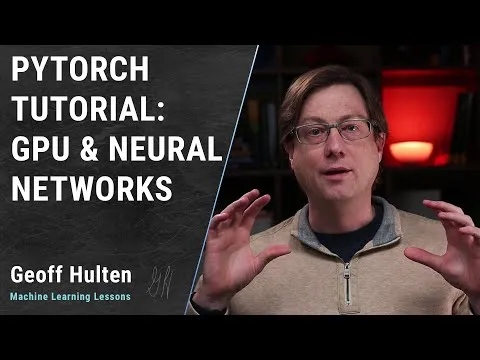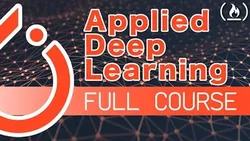
Intro to Deep Learning with PyTorch 
Learn the fundamentals of deep learning with PyTorch in this comprehensive online course. You'll gain hands-on experience building your own deep neural networks and applying them to real-world AI applications like style transfer and text generation. Get ready to take your deep learning skills to the next level! ▼
ADVERTISEMENT
Course Feature
![]() Cost:
Cost:
Free
![]() Provider:
Provider:
Udacity
![]() Certificate:
Certificate:
No Information
![]() Language:
Language:
English
![]() Start Date:
Start Date:
On-Demand
Course Overview
❗The content presented here is sourced directly from Udacity platform. For comprehensive course details, including enrollment information, simply click on the 'Go to class' link on our website.
Updated in [April 29th, 2023]
This course provides an introduction to deep learning and the PyTorch library. Participants will learn the basics of deep learning and build their own deep neural networks using PyTorch. Through coding exercises and projects, participants will gain practical experience with PyTorch and implement state-of-the-art AI applications such as style transfer and text generation. By the end of the course, participants will have a better understanding of deep learning and the PyTorch library.
[Applications]
After completing this course, students can apply their knowledge of deep learning and PyTorch to develop their own deep learning models. They can also use the skills they have acquired to build applications such as image recognition, natural language processing, and computer vision. Additionally, they can use the knowledge they have gained to explore more advanced topics in deep learning such as reinforcement learning and generative adversarial networks.
[Career Paths]
1. Artificial Intelligence Engineer: Artificial Intelligence Engineers are responsible for developing and deploying AI solutions. They use deep learning algorithms and techniques to create AI models that can be used to solve complex problems. AI Engineers must have a strong understanding of programming languages, such as Python, and be able to work with frameworks such as PyTorch. AI Engineers are in high demand and the field is expected to continue to grow in the coming years.
2. Machine Learning Engineer: Machine Learning Engineers are responsible for developing and deploying machine learning models. They use deep learning algorithms and techniques to create models that can be used to solve complex problems. Machine Learning Engineers must have a strong understanding of programming languages, such as Python, and be able to work with frameworks such as PyTorch. Machine Learning Engineers are in high demand and the field is expected to continue to grow in the coming years.
3. Data Scientist: Data Scientists are responsible for analyzing and interpreting data to uncover insights and trends. They use deep learning algorithms and techniques to create models that can be used to solve complex problems. Data Scientists must have a strong understanding of programming languages, such as Python, and be able to work with frameworks such as PyTorch. Data Scientists are in high demand and the field is expected to continue to grow in the coming years.
4. Computer Vision Engineer: Computer Vision Engineers are responsible for developing and deploying computer vision solutions. They use deep learning algorithms and techniques to create models that can be used to solve complex problems. Computer Vision Engineers must have a strong understanding of programming languages, such as Python, and be able to work with frameworks such as PyTorch. Computer Vision Engineers are in high demand and the field is expected to continue to grow in the coming years.
[Education Paths]
1. Bachelor of Science in Computer Science: This degree path provides a comprehensive overview of computer science fundamentals, including programming, algorithms, data structures, and software engineering. It also covers topics such as artificial intelligence, machine learning, and deep learning. This degree is ideal for those interested in developing the skills necessary to build and deploy deep learning models.
2. Master of Science in Artificial Intelligence: This degree path focuses on the development of advanced AI techniques, such as deep learning, natural language processing, and computer vision. It also covers topics such as robotics, machine learning, and data mining. This degree is ideal for those interested in developing the skills necessary to create and deploy sophisticated AI applications.
3. Doctor of Philosophy in Machine Learning: This degree path focuses on the development of advanced machine learning techniques, such as deep learning, reinforcement learning, and unsupervised learning. It also covers topics such as natural language processing, computer vision, and robotics. This degree is ideal for those interested in developing the skills necessary to create and deploy sophisticated AI applications.
4. Master of Science in Data Science: This degree path focuses on the development of data science techniques, such as data mining, machine learning, and deep learning. It also covers topics such as data visualization, data engineering, and data analysis. This degree is ideal for those interested in developing the skills necessary to create and deploy sophisticated data-driven applications.
The development trends for these degree paths include the use of more sophisticated deep learning models, the use of more powerful computing resources, and the development of more efficient algorithms. Additionally, the use of AI and machine learning in various industries is increasing, which is driving the demand for professionals with expertise in these areas.
Course Syllabus
Introduction to Deep Learning
Discover the basic concepts of deep learning such as neural networks and gradient descent,Implement a neural network in NumPy and train it using gradient descent with in-class programming exercises,Build a neural network to predict student admissionsIntroduction to PyTorch
Hear from Soumith Chintala, the creator of PyTorch, how the framework came to be, where it’s being used now, and how it’s changing the future of deep learningDeep Learning with PyTorch
Build your first neural network with PyTorch to classify images of clothing,Work through a set of Jupyter Notebooks to learn the major components of PyTorch,Load a pre-trained neural network to build a state-of-the-art image classifierConvolutional Neural Networks
Use PyTorch to build Convolutional Neural Networks for state-of-the-art computer vision applications,Train a convolutional network to classify dog breeds from images of dogsStyle Transfer
Use a pre-trained convolutional network to create new art by merging the style of one image with the content of another image,Implement the paper "A Neural Algorithm of Artistic Style” by Leon A. Gatys, Alexander S. Ecker, and Matthias Bethge"Recurrent Neural Networks
Build recurrent neural networks with PyTorch that can learn from sequential data such as natural language,Implement a network that learns from Tolstoy’s Anna Karenina to generate new text based on the novelNatural Language Classification
Use PyTorch to implement a recurrent neural network that can classify text,Use your network to predict the sentiment of movie reviewsDeploying with PyTorch
Soumith Chintala teaches you how to deploy deep learning models with PyTorch,Build a chatbot and compile the network for deployment in a production environmentCourse Provider

Provider Udacity's Stats at AZClass
Discussion and Reviews
0.0 (Based on 0 reviews)
Explore Similar Online Courses

Poetry: What It Is and How to Understand It

SEO Chat GPT Prompts and AIPRM extension

Python for Informatics: Exploring Information

Social Network Analysis

Introduction to Systematic Review and Meta-Analysis

The Analytics Edge

DCO042 - Python For Informatics

Causal Diagrams: Draw Your Assumptions Before Your Conclusions

Whole genome sequencing of bacterial genomes - tools and applications

PyTorch Tutorial - Neural Networks & GPU

Applied Deep Learning with PyTorch - Full Course


Start your review of Intro to Deep Learning with PyTorch